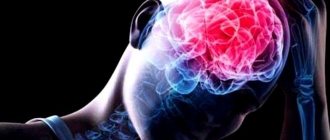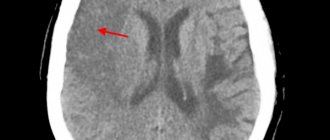Affect and affective disorder. Lecture by Yakovlev V.A.
Affect is strong emotional experiences that arise in critical conditions with the inability to find a way out of dangerous and unexpected situations and which are associated with pronounced motor and organic manifestations. Affects lead to inhibition of all other mental processes and the implementation of corresponding behavioral reactions. Affect occurs sharply, suddenly in the form of a flash, an impulse. In this case, the main characteristics of attention change and only those objects that are included in the complex of experience are retained in the field of perception. All other stimuli are not sufficiently realized, which is one of the reasons for the practical uncontrollability of this state.
History of affect
Historical reference. At the beginning of the 20th century, among the various “feelings”, affects began to stand out as an independent group. Affects were spoken of as emotional reactions aimed at defusing the emotional arousal that had arisen. According to Witwicki, affect is a sensory state that “acquires very significant strength and becomes a general violent disturbance of mental life.” He classified fear, horror, anger, etc. as affects. K. Stumpf, considering feelings a type of sensation, identified affects as a special type of mental phenomena. Gradually, the idea of some independence of affect became established, and when classifying emotional phenomena, it began to be distinguished along with emotional tone, mood, and emotions themselves. In addition to other well-known signs of affects, A. N. Leontiev identifies one that, in his opinion, distinguishes them from emotions: affects arise in response to a situation that has already actually occurred and in this sense are, as it were, shifted towards the end of the event, while emotions anticipate events that have not yet occurred. Emotions and affect are also shared by A. Sh. Tkhostov and I. G. Kolymba. From their point of view, both of these emotional phenomena represent extreme points of a continuum, “defining the main differences. Then affect appears as an uncontrollable, often pointless experience that forms the natural basis of emotions.”
Affective disorders. Affect disorder
Criteria for affective disorder:
- autochthonous appearance of emotions (i.e., not associated with external causes, somatic, endocrine pathology and other physiological disorders);
- lack of emotional reactions to personally significant situations and objects;
- disproportion between the intensity and duration of emotional reactions and the reasons that cause them;
- discrepancy between the quality of the emotional reaction and the reason that causes it;
- disorders of adaptation and behavior due to emotion;
- the unusual nature of emotional experiences, different from what was previously characteristic of a healthy individual;
- the appearance of emotional reactions in response to virtual, unreal, meaningless stimuli.
These criteria do not have absolute meaning; they are quite relative, so that an individual’s emotional reactions can be assessed ambiguously.
In fact, situations very often arise when it is quite difficult and even impossible to distinguish between normal and pathological emotions without further observation of the individual.
Affect disorders
The above criteria for affect are not differentiated clinically, although various and numerous deviations have been indicated. In forensic psychiatry, pathological and physiological variants of affect are distinguished, as well as physiological affect on a pathological basis.
| | Affective disorders respond best to comprehensive treatment in a psychiatric clinic |
The preparatory phase is characterized by the interpretation of psychogeny, the appearance and increase of emotional tension. Acute psychogenia can reduce the duration of the phase to several seconds. A long-term psychotraumatic situation extends the preparatory phase for months, years: the patient during this period for some reason delays in adequately responding to the challenge, and his “spinelessness” can significantly aggravate the situation. The permissive reason (“the last straw”) may be quite ordinary, banal, but it is in connection with it that dire consequences occur. In the preparatory phase, an individual may simply not know, not see a decent way out of the situation; If a psychologist or an experienced psychotherapist had happened, the tragedy might not have happened. Consciousness in this phase is not clouded, but its narrowing is observed in the form of an increasing concentration of attention on the traumatic situation.
Pathological affect is an acute, short-term painful state of a psychogenic nature that occurs in a practically healthy individual (Shostakovich, 1997). Pathological affect occurs in three phases.
The explosion phase occurs suddenly, completely unexpectedly both for the individual himself and for those around him. The main thing that characterizes it is an affective twilight stupefaction. This is a psychophysiological process, and not just the dynamics of involuntary attention. During this period, there may be various affective disorders (anger, despair, confusion, other manifestations hidden under the main affect), phenomena of sensory hypo- and hyperesthesia, illusions, perception deceptions, unstable delusional ideas, disturbances in the body diagram and other manifestations of self-perception disorders. Typically acute psychomotor agitation, which has no connection with the patient’s conscious self, but seems to flow from the depths of his unconscious.
Agitation can be chaotic, aimless, or appear to be completely orderly with aggression directed towards a specific goal. Actions are performed “with the cruelty of an automaton or machine” (Korsakov, 1901). Sometimes they are carried out according to the type of motor iterations: for example, an already lifeless victim continues to be inflicted with countless wounds, blows or shots. It is aggression that reigns supreme; it does not switch over to oneself; suicidal acts, apparently, do not happen. States of pathological affect with rage and auto-aggression probably do not occur at all, or they cannot be identified. Patients are disoriented in place, time, circumstances; It cannot be ruled out that autopsychic orientation is disrupted. Patients can vocalize loudly, pronounce individual words clearly, repeating them, but usually speech becomes incoherent.
Apparently, they either do not pay attention to the speech of others or do not understand it. Non-verbal speech, on the contrary, is animated, it is like instinctive speech, and it can be quite understandable (a grimace of rage, baring of teeth, narrowing of the eye slits or, on the contrary, their widening, an unwavering gaze at the object of anger, etc.). The intellect suffers deeply - the individual performs certain actions without understanding the real situation, without realizing their consequences. The nature of the actions - their special cruelty, the totality of the destruction produced - do not correspond to or even contradict the personal qualities of the individual. There are, for example, patients who are unconfident, defenseless, and devoid of any aggressive tendencies. Violent and extremely aggressive individuals usually commit offenses outside of a state of pathological affect.
The final phase begins as quickly and lightningly as the second. Severe exhaustion, prostration, sleep or somnolence occur. Psychomotor retardation sometimes reaches the level of stupor. This phase lasts within tens of minutes. Upon restoration of clarity of consciousness and activity, extensive congrade amnesia for impressions, experiences and actions of the second phase of affect is revealed. Amnesia can be delayed, and usually after minutes, tens of minutes everything is completely forgotten. Individual memories of the final and, to a greater extent, preparatory phase may be retained. An individual often treats something done in a state of pathological affect as if it had nothing to do with him; he does not appropriate or personalize other people’s stories about what happened.
Cases of pathological affect that occur in connection with protracted mental trauma differ from those described in several significant features. This is a long latent or preparatory stage, development for an apparently insignificant reason, of which there were plenty before, awareness and personification of what was done upon exiting the affect, the polarity of experiences and actions in the affect of the personal qualities of the individual, as well as the fact that immediately or a little later can develop acute depressive reaction to the incident with suicidal actions. Such patients do not try to hide anything or lie; they willingly cooperate with investigative authorities and forensic doctors. Previously, E. Kretschmer designated such variants of pathological affect as short-circuit reactions. Persons who fall into states of such affect are designated in modern literature “as overly self-controlled aggressors.” The exclusion of short-circuit reactions as a special variant of pathological affect is associated, we believe, with ignoring important significant distinctive features between them.
Physiological affect on a pathological basis (Serbsky, 1912) is a transitional form between physiological and pathological affects. The pathological basis of such affect most often appears to be psychopathy, alcohol dependence, possibly other forms of chemical and non-chemical dependence, PTSD. V.P. Serbsky believes that the degree of impairment of consciousness is insignificant.
Typically there is a discrepancy between the strength of the affect and the real significance of the cause that caused it. The affect can be intense to such an extent that it becomes, as it were, the main cause of a serious offense. A common example of such affect are frequent cases of alcoholic (other) intoxication, when at some point the patient’s self-control turns off, the affects of anger come to the fore, hostility, jealousy, a feeling of revenge, a tendency to destructive actions, brutal fights, etc. arise. In another observation with O.A., 39 years old (“schizotypal personality disorder”), after a quarrel with her husband, the patient and her daughter locked themselves in the room with the thought of killing her and herself.
When asked to open the door, she responded with a threat to kill her daughter and herself. Then, she said, she “blacked out.” The relatives, having entered the room, hardly tore the diseased knife out of their hands. “They said that at that time I was crying and laughing.” Then she “felt hands, a knife, and began to come to her senses.” She says that she seriously intended to kill herself and her daughter, but “something inside prevented me from doing it.” Due to the high frequency of such things, questions of sanity are raised very rarely. Here, however, very difficult situations can arise, so that the usual forms of their assessment can give rise to reasonable doubts in the forensic psychiatrist. The possibility that a pathological or physiological affect may arise on an alienated part of one’s self is never excluded.
Physiological affect is a state of very pronounced affect without clear signs of a twilight state of consciousness. Usually, different, including significant, degrees of affective narrowing of consciousness regarding external as well as internal impressions are noted. Physiological affect also occurs in three stages, although it is quite difficult to clearly distinguish between them. Clinically obvious signs of narrowing of consciousness are believed to be observed only in the second phase of affect. The painful episode does not end with pronounced prostration, sleep and somnolence; amnesia is partial. In a state of physiological affect, patients can commit illegal actions - affectdelict. Illustration (Shostakovich, 1997):
K., 42 years old, specialized secondary education (accountant). By nature, vulnerable, touchy, impressionable. At the age of 17 she suffered a spinal fracture. She separated from her first husband because of his drunkenness. The second husband drinks heavily, is jealous, and beats her. Has a 7 year old son from him. During the next conflict, she killed him.
She reports that in recent years she has lived in constant fear, “experienced panic and horror.” I didn’t want to live, I didn’t see any other way out of the situation than to commit suicide. On the day of the offense, the husband came home drunk and immediately began to scold her, beat her, and hit her in the body. She tried to hide in the bathroom, but he pulled her out and began to choke her in the kitchen. She says that she experienced “terrible fear” and thought that he would kill her. She notes that she saw everything as if in a fog, only she saw his eyes clearly. She remembers how she ran away from the room, hid, and thought that he wouldn’t chase her. She doesn’t remember how she beat him with a knife, where she took it and how such an idea came to her. He doesn’t remember how long it took to kill his husband and how it all happened. When I came to my senses, I felt weak, tired, and my hands were shaking. Entering the kitchen, I saw my dead husband and realized that it was she who killed him.
She called an ambulance and the police. Psychological research has established that the subject is impressionable, vulnerable, prone to “accumulating negatively colored experiences” and avoiding conflicts; It is difficult to find constructive ways out of conflicts (which ones are not specified), and has a type of intraputative response to difficult situations for oneself (for example, suicidal tendencies). Psychologists do not mention the presence of signs of increased aggressiveness. A comprehensive examination found her to be healthy. The conclusion of the expert commission indicated that the subject was in a state of physiological affect. That's probably what happened. But this case does not contain evidence that there are no states transitional between indisputable cases of pathological affect and the much more frequent states of physiological affect.
This situation, not without serious comparisons, could be regarded as a short circuit reaction. Psychiatry is poorly suited to Euclidean paradigms, based on the priority of visual behavioral impressions, which ignore the fact that internal psychological factors can radically change the sensations, perceptions, interpretations, emotional reactions and behavior of a person, including the researcher himself.
There are a number of painful affects that are not classified as pathological solely because they do not entail violence, although sometimes they are capable of this. Let's name some of them.
Confusion (“affect of bewilderment”, according to S.S. Korsakov). It is manifested by an absolute lack of understanding of the current situation, which is explained by the disintegration of the intellect and the inability to synthesize different impressions, as well as to search for the same or similar ones in memory. This bewilderment is usually combined with fear, anxiety, a feeling of complete helplessness and the patient’s unsuccessful attempts to understand what is happening by seeking help from those present.
Disturbances in orientation in place, situation, time, environment, and sometimes in oneself are typical. Contact with the outside world, the consciousness of which is often preserved, is one-sided: patients usually ask peculiar questions, without addressing anyone in particular, but do not react to the answers, do not take them into account, perhaps not always understanding their meaning. Fear and anxiety are typical, and the mood is mostly depressed. There may be motor agitation with fussiness and akinesia. Hypermetamorphosis is observed, and occasional productive disorders occur (perceptual deceptions, delusions, episodes of confused consciousness, symptoms of mental automatism).
Patients ask one question after another like: “What kind of room is this? Where are you taking me? Why are you wearing a white coat? Why are you writing? Who are these people? Where am I? What does all of this mean?" Or: “I don’t understand whether I’m alive or dead? Where am I? Is anybody here? I think the coffin is here. Am I conscious or unconscious? They don’t give me mirrors, I don’t know if I have a face or not? Am I a man or not?.. It seems like I’m a man. Am I in this world or no longer? What's the matter? They cut, burn, electrify. The scenery changes all the time. Are you relatives, a doctor or someone from prison? Have I really done something? Where am I going now? In the first case, confusion concerns more external impressions; attention constantly moves from one object to another. In the second case, the patient is more concerned about what is happening to himself, in his behavior. At the same time, violations of self-perception are revealed, up to the loss of one’s identity and autometamorphosis, the feeling of reincarnation into another being; delusional ideas of influence, staging. The condition of the patients in both cases approaches amentia, and their thinking approaches fragmentation.
Let us recall that with the actual fragmentation of thinking, there is no confusion and elementary orientation is most often not disturbed; patients seem to understand what is happening, sometimes they behave quite orderly and do not react to their lack of understanding of the essence of what is happening, as well as to the lack of coherence of thinking. Confusion is often encountered during the acute onset of schizophrenia (Kerbikov, 1949). Brief episodes of confusion (“stupidity”) are very common when a patient first appears at the doctor’s office. Entering the office, the patient seems lost, looks around, does not understand where to sit, or asks about it, even though the only chair for conversation has been prepared for him. Confusion is an ominous sign, especially often in schizophrenia, when the patient’s role is not accepted immediately or not at all due, probably, to depersonalization.
Panic fear - spontaneously occurring and short-term states of “terror” with confusion, motor agitation with the desire to run somewhere, make frequent calls to the ambulance, pronounced autonomic disorders (high rises in blood pressure, difficulty breathing, frequent urination, vomiting, profuse sweating) and many others). Fear or a feeling of madness, loss of self-control, phenomena of mental anesthesia, and painful physical sensations, such as senestopathy, often occur. Attacks of fear occur spontaneously and completely suddenly, sometimes patients sense their approach.
They can arise for random provoking reasons, and then patients also “wind up themselves” with ideas about an impending catastrophe, mistaking fantasies for something that has already happened or for something that will certainly happen. At first, the attacks are sporadic and not so often repeated. Then they can become more frequent and occur several times a day, lengthening to several tens of minutes (usually patients begin to immediately take something sedative, especially tranquilizers, alprozalam), call an ambulance (up to 6-10 times a day). Usually there remains an obsessive fear of recurrence of attacks and anxious anticipation of them. Patients try to avoid visiting places with which they associated the occurrence of attacks, they are afraid to be alone with themselves at home or on the street, some cannot stand riding in public transport, do not risk using the elevator, etc. As a rule, they do not part with their medications. Gradually, patients seem to get used to the attacks, realizing that they are not fatal and can be stopped without much difficulty. There are patients who indicate a seasonal pattern of attacks.
Illustrations: “In the evening after work, a thought suddenly came to me: what if one of the customers cast a spell on me. Fear immediately arose, animal fear, to the point of horror. It seemed like I was going crazy and would do something crazy. I rushed around the house, completely confused, didn’t know what to do... I visited my grandmother, she treated me with prayers. Suddenly it seemed to me that she had missed some necessary word in the prayer. It got worse than ever before. I feel my heart pounding, blood pressure rising, lack of air, dizzy, pain in the pit of my stomach, everything floats around, sways, seems unreal, everything is mixed up in my head like madness. And fear, wild, indescribable fear to the point of horror. I couldn’t sit still, I jumped off and ran to the other grandmother. Suddenly it becomes eerie, everything floats, it’s unreal, it seems that I’m going crazy, I don’t recognize myself, as if it’s not me anymore.”
Some authors try to distinguish panic disorder into attributive, i.e., psychogenically caused attacks, alexithymic - “without the experience of fear”, hypertypic - without the experience of fear before and after the attack, “existential crises” - with fear of a bodily catastrophe, accepting, it seems, taking into account less significant or even dubious signs.
The terms “panic disorder” or “ panic attack” are not entirely accurate, since in a painful state there is not an objective, conscious fear, but unaccountable anxiety, autopsychic confusion and many other disorders, among which an acute violation of self-perception (depersonalization, derealization, tendency to accept imaginary reality, phenomena of mental anesthesia). With that said, a more accurate term would be “acute anxiety attack with depersonalization.”
Moreover, a significant, if not the overwhelming majority of patients subsequently develop distinct anxious depression with symptoms of pathology of self-perception. Neurologists previously identified “diencephalic attacks” with very similar symptoms, although with an emphasis on somatovegetative and neuroendocrine disorders. Panic itself is a symptom of an acute reaction to a sudden and severe psychologically traumatic situation, often fraught with disaster for many people. Such panic is accompanied by confusion, psychomotor agitation, or stupor. There have been cases of mass panic. There are no cases of widespread "panic disorder", although individual patients can induce each other, usually exacerbating the severity of the disorder.
Ecstasy is a state of extreme, expressed to the point of frenzy, or, less commonly, another emotion. Here is a description of a typical ecstatic state at the beginning of an epileptic seizure (sometimes a focal emotional attack): (It is) “an extraordinary inner light ..., delight ..., the highest calm, full of clear, harmonious joy and hope, full of reason and final reason, (which) turns out to be the highest degree of harmony, beauty, gives a hitherto unheard of and unexpected feeling of completeness, proportion, reconciliation, enthusiastic prayerful merging with the highest synthesis of life, self-awareness and ... self-awareness in the highest degree immediate, (which) in itself was worth all life” (F. M. Dostoevsky).
Orgiastic states are ecstasy that occurs during ritual actions, for example, the ritual of shamans, the dancing of dervishes. Other participants in sacred ceremonies usually also fall into ritual ecstasy if they have fully identified themselves with other members of the group. This type of ecstasy is characterized by possession by a spirit, good or evil. In the first case, members of the ritual group experience a feeling of supreme, endless happiness, jubilation, admiration, power that does not occur in ordinary life, with a feeling of loss or dissolution of their Self, as well as a change in identity.
In the second case, violent rage, rage, senseless and chaotic aggression predominate. The consciousness of the Self also disappears, all feelings and actions have their source in some internal demonic principle. Some sacred rites encourage unrestricted sexual relations, so that the rite ends in a mad orgy. A number of sects have a practice of mass immersion of their adherents into ecstasy, during which awareness of their Self is also lost and self-identification with a charismatic leader occurs. The memory of the experience of ecstasy is preserved, although perhaps not fully. Memory for what is happening around is not retained. In satanic sects, ecstasy is experienced as self-identification with Satan; adherents are possessed by anger, rage, and bloodthirstiness.
Mystical ecstasy is achieved through special exercises that make it possible to experience a feeling of merging with God or another higher power. It is in such states that “insights” arise, “revelations”, “signs from above” are perceived, followed by belief in them as some higher, absolute, indisputable truth.
Meditative ecstasy is “waking dreams,” an uncontrollable flow of dreams in which one experiences a feeling of belonging with transcendental entities, with the essence of something else, inaccessible through ordinary knowledge of the world.
Prayerful ecstasy is a state of delight, bliss, a feeling of merging with God or his Divine will, a feeling of unity with him, merging with him. It is observed among deeply religious people, but is more typical, apparently, of fanatical believers who have no doubt that their faith is the only true and unshakable one. All other religious movements of the spirit are “from the evil one.”
Manic ecstasy is a feeling of inexpressible admiration and delight, observed in some manic patients somewhere at the height of the painful state. This is a special type of mania, involving an altered state of consciousness and a persistent focus on ideas of sublime content; in typical cases of mania, hypervariability of attention and personality regression are usually observed.
Hypnotic ecstasy is an ecstatic state usually instilled during a state of deep hypnotic sleep. Not all patients experience such an extraordinary feeling as ecstasy in hypnosis. There must probably be some kind of internal predisposition to this. Oneiric ecstasy is observed in a state of manic-ecstatic oneiroid, when dreams and other painful phenomena are produced with the content of “heavenly,” extraterrestrial, cosmic, otherworldly existence, generated by higher, previously unknown forces of love and infinite goodness. These are, as it were, the spiritual quests of patients carried out in a painful state.
Ecstatic dreams are a special type of dreams in which unusually bright, colorful, enchanting images are captured with experiences of extraordinary happiness, amazing beauty that has absorbed the ordinary world and presented it as a kind of vague prototype of reality. Patients talk about an inexplicable feeling of delight, admiration for a different, extremely attractive and only acceptable image of the universe that has become open, tangible and real. Mixed with all this is the feeling of reincarnation as “the queen of the world, a deity, an angelic creature, a messenger of Heaven in the sinful material world.”
It is difficult to explain such metamorphoses without knowing the human essence that rushes upward. Coming out of psychosis, some patients remain confident that they have seen with their own eyes the real world, and not some surrogate in which people are doomed to exist. Sometimes such dreams retain the force of reality for a long time, and patients stop themselves from trying to discredit this dream - “reality”.
There are very few, if not almost non-existent, reports of ecstatic episodes from religious patients. Nevertheless, G.V. Morozov and N.V. Shumsky (1998) talk about the frequency of states of ecstasy when pseudohallucinatory memories arise.
In a state of ecstasy, stupor, incomprehensible, as if symbolic psychomotor agitation, disconnection from reality, desomatization phenomena, disturbances in the sense of time are usually observed (the latter “lengthens” or stops altogether; F.M. Dostoevsky reports that once Mohammed “examined” all the details of a vast Muslim paradise. The long journey of the prophet did not last long, according to earthly time, one moment, during which not a drop spilled from the overturned cup of wine).
Memory for subjective experiences during a period of ecstasy is often preserved to the smallest detail (apparently, this is imprinted in memory as in selective hypermnesia, as something of exceptionally great personal significance). Memories of what is happening around are incomplete, inaccurate, distorted, and many are not retained in memory. The duration of ecstatic episodes ranges from a few seconds to a number of hours. Patients treat ecstatic experiences as the greatest value of their lives.
Amazement is an extreme degree of surprise with stopping the flow of thoughts, freezing in one position, a frozen expression on the face on which surprise froze, and at the same time falling silent. It occurs, as mentioned, when something very unusual, incredible, and directly contradicts the individual's absolute confidence in what should happen.
Enrage is an extreme degree of excitement with loss of self-control, most often occurring during frustration and manifesting itself in the form of impotent anger (Ilyin, 2002).
Back to contents
Causes of affect
Among the causes of affect are:
- The emergence of circumstances that threaten a person’s physical existence, related to his biological instincts and needs.
- Conflict, contradiction between a person’s strong attraction, desire, desire for something and the objective impossibility of satisfying the urge that has arisen.
- Actions of others that affect a person’s self-esteem and traumatize his personality.
Affect arises in an already existing specific situation and serves for the subject as a unique form of exit from it, a release. In an affectogenic situation, a person must act and feels an irresistible need to do so, but does not find suitable methods of action. This contradiction is what causes the affect. If a person clearly sees the possibilities of adequate behavior, affect does not occur.
Individual psychological characteristics predisposing to the development of affective states are:
- A complex of innate properties of the nervous system (in people with a weak type of nervous system, which is characterized by mild excitability, increased sensitivity to stimuli, low resistance to strong stimuli).
- The specific structure of personality, in particular, the features of its self-esteem.
- Age characteristics of the subject.
- Temporary functional psychophysiological states that disrupt a person’s resistance to an affectogenic situation (fatigue, insomnia, menstrual periods in women, etc.).
Ya.M. Kalashnik. Pathological affect Added by Psychology OnLine.Net 10/08/2010 (Edit 10/08/2010) (...) The term “pathological affect” appeared in psychiatric literature in the second half of the 19th century, although this psychopathological condition itself was known somewhat earlier under the names “insanity”, “angry unconsciousness”, “mental confusion”, “morbid temper”, etc. Even at the beginning of the 17th century. Pavel Zacchias, in his classification of mental disorders, distinguished passions as short-term mental disorders; according to Zacchias, crimes committed in these states deserved a more lenient sentence. Subsequently, all states arising as a result of strong “passions”, unrest, especially anger, unexpected humiliation, insult, etc., are combined into a general group of so-called transient fury, temporary or temporary insanity (mania transitoria, furor transitorius, etc. . P.). Particular attention was paid to conditions that were later called “pathological affect.” (...) This designation was found by Krafft-Ebing, to whom the term “pathological affect” belongs. (...) After Krafft-Ebing, a number of psychiatrists studied pathological affect (Korsakov, Kandinsky, Sherbak, Ivanov, Botkin, Chizh, Serbsky, etc.). (...) Research on pathological affect concerns the state of consciousness during it and the question of the dependence of pathological affect on the soil on which it arises. On such an urgent issue as the question of the degree of disorder of consciousness in pathological affect, there is no consensus among old authors. Some believed that with pathological affect there may be “dreamy confusion”, “a state of painful unconsciousness” (Krafft-Ebing), “more or less sharp clouding of consciousness” (N. M. Popov), that a person with pathological affect is “almost complete or completely complete absence of consciousness” (Kasper), that “consciousness can be deeply upset or darkened” (Serbsky). Others considered pathological affect “a short-term psychosis that may not be accompanied by a blackout of consciousness” (Mittermeyer), and in this state “actions can be recognized with unusual brightness” (Botkin). There was a third point of view expressed by Korsakov. Korsakov identified two types of pathological affect and believed that with pathological affects of one type, a disorder of consciousness manifests itself with particular sharpness, expressed in its darkness. Pathological affects of another type, according to Korsakov, are characterized not so much by clouding of consciousness as by a decrease in the influence of higher delays. (...) Some authors (Portugalov) go further and believe that the forms of decomposition of consciousness during pathological affect are not always built according to one template, but can manifest themselves in various staging, similar to the clinical syndromes of various mental illnesses, occurring as if in an extremely shortened period of time. Here one can observe stupor, an amental picture, a twilight state similar to an epileptic one, and even short-term hallucinosis. (...) Usually affects appear in cases of sudden and sharp irritation, to which it is difficult to immediately adapt. This is where the whole range of symptoms arise that characterize disorganized behavior and disruption of the flow of mental processes. This is especially noticeable when the affects of rage, anger and fear are strongly expressed, which are most often the subject of forensic psychiatric research. Actions during such affects are, as Serbsky says, “reflexive in nature, they lose the imprint of voluntary actions, although they may consist of complex acts.” The motor reaction, since it develops against the background of altered consciousness, is “spontaneous in nature and is expressed in acts of brutal violence, infliction of severe injuries, and murder” (Gilarovsky). With pathological affect, a number of symptoms appear in terms of blood circulation, blood supply to blood vessels, changes in Breathing, and facial expressions. A number of authors consider a disorder of vascular innervation and impaired blood circulation in the brain to be the cause of impaired consciousness. (...) Many authors attach important diagnostic significance to the presence of depletion of mental and physical strength that occurs after violent manifestations of pathological affect, as well as the presence of amnesia about events relating to the period of the crime. lenia, which is seen as an expression of a former disturbance of consciousness. There is no consensus on the issue of the dependence of pathological affect on soil. Korsakov, for example, believed that pathological affects in some cases can arise on the basis of latent psychosis or a psychopathic constitution, in others they have an independent character, sometimes they can occur in people who do not present noticeable signs characteristic of one or another psychopathic constitution, and almost always arise as a consequence of a very strong emotion. In contrast to these views, a number of authors (Chizh, Shcherbakov, Ivanov, etc.) believe that healthy people who are not carriers of pathological soil cannot have pathological affect. (...) The apparent contradiction in this matter depends not so much on different views on the essence of pathological affect, but on different understandings of the terms “pathological soil” and “pathological personality.” Some authors classify only clinically expressed forms of mental illness as pathological personalities, classifying the rest as healthy. Others, on the contrary, also include the so-called borderline cases as pathological personalities: alcoholics, neurotics, psychopaths, some epileptics, etc. (...) Some authors even include the general cultural level of a person among the predisposing reasons, believing that pathological affect can arise as a result of savagery and bad manners. “Upbringing,” says Chizh, “fear of condemnation by public opinion and fear of punishment helps us control ourselves, and therefore crimes of passion become less common with the growth of culture.” (...) Pathological affect, no matter how short-lived it may be, has its own course and passes through certain phases: the preparatory phase, the explosion phase and the initial or final phase. For each of these phases, a violation of consciousness and its individual components (memory, perception, stock of ideas, etc.) has its own characteristics. Portugalov described each of these phases in detail as follows. The preparatory phase is characterized by the fact that consciousness is preserved in all cases. Pathological affect at the beginning of its development, when tension of emotions appears and the concentration of ideas on a certain focus of attention, cannot occur against the background of an unconscious state. Perception in this phase, right up to the onset of an explosion, is only slightly disrupted, and the inability to observe and realize the ongoing mental processes and experiences is disrupted. The poor, very narrowed circle of Ideas is sharply colored emotionally. Mental activity becomes one-sided due to the sole desire to fulfill one’s intention. The rest of the personality, since it contradicts this, seems to cease to exist. The second phase of pathological affect - the explosion phase - from a biological point of view is a process of reaction. Here, pathological affect appears as a complex of a strong feeling tone, requiring immediate response. Volitional disorders manifest themselves in a violation of the usual balance between increased impulses and a weakened inhibitory apparatus, i.e., in what is called loss of self-control. In the area of ideas, there is a chaotic change of ideas. Consciousness in this phase is disrupted, the clarity of the field of consciousness is lost, and its threshold decreases. According to the description of some subjects, at the time of the offense they were in a fog, as if in a dream, and did not remember anything about it. Aggressive actions observed in this phase, being caused by revenge, jealousy, envy, etc., are usually expressed in attack, destruction, struggle, anger, rage, indignation. In some cases, instead of aggressive actions, behavior acquires a passive character and is expressed in confusion, aimless fussiness, lack of understanding of the situation, etc. Thus, at this stage of pathological affect, two lines of behavior appear: in one case - the desire to repel, attack, in the other is the desire to run away, to hide. The third - initial or final - phase is mainly characterized by depletion of mental and physical strength. Affect, as a state of highest internal tension, is a physiologically enormous work, accompanied by the expenditure of a large reserve of strength, therefore it inevitably leads to rapid exhaustion of the nervous system, which is expressed in a certain mental dullness, indifference and indifference to everything around, and sometimes a tendency to sleep. Some time after the restoration of strength, a disturbance in the memory of events relating to the period of development and explosion of pathological affect is discovered. This sequence of development of pathological affect can be traced in the following example1. Case 22. Sh., 52 years old, had suffered from typhoid and typhus in the past. While working as a railroad driver, he was involved in train accidents several times and suffered head injuries. Abused alcohol. About ten years ago, he developed headaches, noise in the head, ringing in the ears, palpitations, became irritable, hot-tempered, slept poorly, and periodically experienced melancholy. Twice he spent a short time in psychiatric hospitals, from where, based on changes in the cardiovascular system (dull heart sounds, hard peripheral vessels), some intellectual decline, weakened memory, increased fatigue and mental exhaustion, he was discharged with a diagnosis of cerebral arteriosclerosis. His performance decreased and he was placed on disability, although he continued to work in fits and starts. After an episodic illness, he submitted a sick note for payment. The cashier of the insurance office withheld the ballot to clarify the question of whether the subject, as a disabled person, can receive money from the ballot. The subject left the cashier with a feeling of resentment and insult, believing that he was suspected of an illegal act without reason. Two days later, the subject came again for the money and the selected pension book. Since the cashier stated that nothing had yet been clarified in his case, the subject fell into an excited state and inflicted several wounds on the cashier with a pocketknife, which was always with him. According to the description of witnesses, at that moment he “looked like a madman,” “his eyes were crazy,” his face was pale. He then fell and was unconscious for some time. Of what happened, he only remembers episodes dating back to the very beginning. He remembers how he demanded the cashier return his pension book, remembers how he refused his request and then went to the closet, from where he took something and put it in his pocket. It seemed to him that it was a revolver. My vision darkened and my heart began to beat. He doesn’t remember what happened next. The expert commission of the institute concluded that Sh. suffers from cerebral arteriosclerosis. He committed the offense in a state of pathological affect, which arose on the basis of the above changes and was expressed, as can be seen from the case materials, in senseless, inadequate aggression, accompanied by a change in consciousness and ending in a fainting state. Therefore, in relation to the act charged with him, the subject was declared insane.
The emergence of such a state in the subject was preceded by significant affective preparation with a gradual increase in affect towards the “offender” due to the fact that the subject was suspected of an unseemly act. During the second visit, the subject took the refusal to give him the pension book he needed due to the already existing affective preparation even more acutely. Added to this was an illusory interpretation of the cashier’s movements: it seemed to him that he had picked up a revolver to shoot at him. All this served as a direct reason and impetus for the transition of affect into the explosion phase with aggressive actions. Everything that follows occurs with impaired consciousness with noticeable facial and vasomotor changes. And finally, in the final phase, a deep fainting state occurs as an expression of severe exhaustion of mental and physical strength. The subsequent amnesia extends not only to this last final phase, but also to the period of the explosion. This pathological affect developed on inferior soil, mainly created by cerebral arteriosclerosis, in which the combination of weakness, incontinence of affect and vasomotor disorders greatly contributes to the development of pathological affect. As we indicated above, the most characteristic feature of the state of pathological affect is the onset of mental and physical exhaustion in the final phase. In the above case, pronounced exhaustion indicates that the strength of the affect was so great that it was capable of transforming voluntary mental activity into involuntary one. Recognizing this symptom is not difficult, but faking it is not easy. Usually, as observations show, after a pathological affect, sleep does not occur so often, and then only in cases where intoxication is added to the affect or when the affect occurs in an inferior person (mostly with organic defects, as in the above case in an arteriosclerotic person). Most often, exhaustion is manifested by relaxation, disturbance of gait, facial movements, facial expressions, the face takes on an exhausted, tired expression, legs can barely move, objects fall from hands, the attitude towards the environment is dull and indifferent, it can be difficult to collect thoughts, an indifferent attitude towards the crime committed followed by repentance. (...) To illustrate some of the features, we present the following case of pathological affect that developed in a psychopath.
Case 3. M., 31 years old, was often ill as a child and did not do well at school. He was in the army and at the front, wounded. I was always sensitive and irritable; at times I felt sadness and disappointment in life, and had thoughts of suicide. He was under the supervision of a district psychiatrist with a diagnosis of psychopathy. He was treated several times in sanatoriums, from where he was discharged with improvement. He often quarreled with his wife, he is very attached to the child, devotes a lot of time to him, nurses him. Circumstances of the offense. Around midnight, the subject’s neighbors, young spouses, “caused a fuss in their room,” danced, ran after each other, and finally both fell on their bed. The thin plywood partition separating their room from the subject’s room fell down. The child woke up from the loud noise of the falling wall and began to “scream wildly.” M., who at that time was closing the window with a stick, suddenly fell into a sharply excited state, changed his face, screamed something incoherently, pushed his wife away from him, rushed into the corridor, attacked the frightened neighbor standing there and struck him several blows A stick to the head. Then, screaming, he ran to his room, threw himself into bed and lay for some time as if in oblivion. When he woke up and learned about what had happened, he was very surprised, since he did not remember anything from the moment he jumped off the window. He had never had any previous confrontations with the beaten man. Physical condition without deviation from the norm. On the part of the nervous system, only increased general excitability and live tendon reflexes are noted. Mental condition. Clear consciousness, correct orientation in place, time and environment, depressed mood; emotionally unstable, irritable, capricious, touchy, requires increased attention, somewhat annoying. There are no delusions or hallucinations. The expert commission came to the conclusion that the subject is a psychopathic person and is sane in his normal state. The incriminated offense was committed by him in a state of temporary mental disorder in the form of pathological affect, expressed in aggression and excitement, inadequate to the situation, with subsequent forgetting of what was committed. In view of this, in relation to the act accused of him, he was declared insane.
Typical of affective states is that actions, no matter how strong and destructive they are, almost always have their focus on a certain circle of people with whom affective ideas are associated—at the offender, rival, etc. From the entire group short-term disorders of mental activity most often and most often the direction of actions occurs with pathological affect. If we take the twilight state of an epileptic or a state of pathological intoxication, then in these cases the behavior is most often distinguished by its inconsistency, absurdity and often the complete absence of a reason for certain actions and aggressive acts. An example is the behavior of one subject who underwent examination at the institute and was accused of hooliganism committed in a state of undoubted pathological intoxication. The subject drank wine with his friends in a restaurant. He doesn’t remember what happened next. From the criminal case it is clear that he, being drunk, entered a courtyard unfamiliar to him, climbed up the stairs to the roof of the house, broke out a dormer window and through the attic got into the kitchen of this house, broke the glass in the apartment windows, broke dishes, destroyed the stove, and began to strangle the frightened woman. the landlady and then immediately went to bed. From here he was taken to the sobering center. Such behavior with a tendency to actions carried out without a visible goal or need usually does not occur with pathological affect, unless alcohol is mixed into it. When assessing pathological affect, it is necessary to keep in mind that an aggressive act committed in a state of pathological affect usually does not fit with the correct, polite and restrained behavior of the subject in a normal state. Therefore, in terms of the nature of the reaction, pathological affect is often considered as an alien episode that unexpectedly burst into the human psyche and is unusual for a given individual, although understandable in its mechanisms. This discrepancy between normal behavior and behavior during affect should be taken into account, although very carefully. As a consequence of this discrepancy between behavior in affect and the character of the individual, there is a feeling of surprise at what was done, regret and repentance. One more feature of pathological affect should be pointed out - the absence of a preliminary plan and the use of objects that accidentally come to hand as tools. As Goffman rightly points out, the presence of a planned action and evidence that the action was already prepared in advance, during an unchanged consciousness, strongly speaks against pathological affect. In a number of cases, the explosion phase occurs in an extremely short period of time and this brings pathological affect closer to a “short circuit” state. The name "short circuit" (Kurzschlusshandlungen, in German terminology) is taken from the field of electricity, where a short circuit is said to occur in cases where the current passes through the shortest suddenly opened path with reduced resistance. Similarly, the short-circuit reaction in a person is characterized by sudden actions in which affective impulses turn directly into actions, bypassing the whole personality (Kretschmer). A person commits an act under the influence of some thought suddenly, “without thinking about anything else.” All of the above cases of pathological affect indicate that the soil on which this condition develops can be varied. As the institute's material shows, in some cases, pathological affect can arise under the influence of prolonged affective tension, threats, fear and temporary neuropsychic exhaustion in mentally healthy people. When making a diagnosis of pathological affect, one should pay attention to whether the nature of the offense is in conflict with the personality characteristics of the subject; it is necessary to find out whether there was no systematicity in actions when excited, what is the direction of aggressive acts. Particular attention should be paid to the main symptoms of pathological affect - impaired consciousness, exhaustion and amnesia - and their place in the very process of development of this condition. However, we must remember that these symptoms are far from absolute value. Each of them, if taken in isolation from other signs, may seem very conclusive in favor of the pathology of the condition. But if we take into account the characteristics of the entire given personality and take into account the dynamics of the condition, then the symptom, which seems evidential and indisputable, begins to lose such meaning. (...) We should also dwell on amnesia as one of the symptoms of pathological affect. Complete amnesia in pathological affect is quite rare and only at its deepest degrees. Most often, partial amnesia occurs when, against the background of general amnesia, during a skillful conversation with an expert, individual details, islands of memories emerge in the subject’s memory. Often in these cases, memories emerge from the subconscious sphere, where individual facts have been repressed. Partial amnesia does not at all speak against the pathology of the condition. For these reasons, it is not always possible to talk about complete unconsciousness in pathological affect. (...) The range of affectogenic disorders also includes physiological affect. Affective movements of this kind are a common occurrence, and they can develop in anyone in an environment of threat, attack, jealousy, etc. A distinctive feature of physiological affect is the absence of a disturbance of consciousness characteristic of pathological affect. In addition, the explosion phase of physiological affect usually proceeds with less subsequent disturbance of memories, and in the decline phase it is not so much exhaustion that comes to the fore as a subjective feeling of relief and remorse. Typically, physiological affect is a response to a strong emotional stimulus. (...) Physiological affect occurs with relatively intact consciousness, there is no amnesia, actions manifest themselves in a form adequate to the nature of strong irritation, followed by a subjective feeling of relief. Physiological affect is a state that does not exclude sanity. (...) This concept... should not, however, be widely used. Great caution in assessing these types of conditions requires cases where affect occurs frequently and is associated with habitual disinhibition, not caused by any painful process.
- A description of this case is given by Razumovskaya in the textbook “Forensic Psychiatry”, 1938.
| Description | Problems of forensic psychiatry. Sat. 3. Ed. Ts. M. Feinberg. M. s. 249-254, 260-268, 275-280. Published by: Psychology of Emotions. Texts / Ed. Yu.B. Gippenreiter, V.K. Vilyunas. M., 1984. |
| Rating |
0/5 based on 0 votes. Median rating 0. |
| Tags | emotions, affect, Kalashnik, reader, Vilyunas, Gippenreiter |
| Views | . On average per day. |
Types of affect
The following types of affect are distinguished:
- Classic affect. A rapid, violently occurring emotional reaction of an explosive nature. It lasts for an extremely short period of time, after which a decline occurs.
- Cumulative affect. The first phase of cumulative affect is usually very extended over time - from several months to several years. During this time, a psychotraumatic situation develops, which causes the cumulation (accumulation) of emotional stress. An affective explosion in itself can occur due to a minor reason, which plays the role of the “last straw”.











